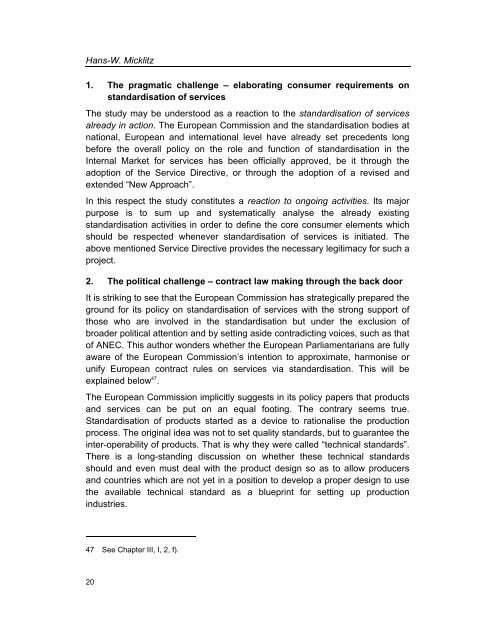Services Standards: Defining the Core Consumer Elements ... - ANEC
Services Standards: Defining the Core Consumer Elements ... - ANEC
Services Standards: Defining the Core Consumer Elements ... - ANEC
You also want an ePaper? Increase the reach of your titles
YUMPU automatically turns print PDFs into web optimized ePapers that Google loves.
Hans-W. Micklitz<br />
1. The pragmatic challenge – elaborating consumer requirements on<br />
standardisation of services<br />
The study may be understood as a reaction to <strong>the</strong> standardisation of services<br />
already in action. The European Commission and <strong>the</strong> standardisation bodies at<br />
national, European and international level have already set precedents long<br />
before <strong>the</strong> overall policy on <strong>the</strong> role and function of standardisation in <strong>the</strong><br />
Internal Market for services has been officially approved, be it through <strong>the</strong><br />
adoption of <strong>the</strong> Service Directive, or through <strong>the</strong> adoption of a revised and<br />
extended “New Approach”.<br />
In this respect <strong>the</strong> study constitutes a reaction to ongoing activities. Its major<br />
purpose is to sum up and systematically analyse <strong>the</strong> already existing<br />
standardisation activities in order to define <strong>the</strong> core consumer elements which<br />
should be respected whenever standardisation of services is initiated. The<br />
above mentioned Service Directive provides <strong>the</strong> necessary legitimacy for such a<br />
project.<br />
2. The political challenge – contract law making through <strong>the</strong> back door<br />
It is striking to see that <strong>the</strong> European Commission has strategically prepared <strong>the</strong><br />
ground for its policy on standardisation of services with <strong>the</strong> strong support of<br />
those who are involved in <strong>the</strong> standardisation but under <strong>the</strong> exclusion of<br />
broader political attention and by setting aside contradicting voices, such as that<br />
of <strong>ANEC</strong>. This author wonders whe<strong>the</strong>r <strong>the</strong> European Parliamentarians are fully<br />
aware of <strong>the</strong> European Commission’s intention to approximate, harmonise or<br />
unify European contract rules on services via standardisation. This will be<br />
explained below 47 .<br />
The European Commission implicitly suggests in its policy papers that products<br />
and services can be put on an equal footing. The contrary seems true.<br />
Standardisation of products started as a device to rationalise <strong>the</strong> production<br />
process. The original idea was not to set quality standards, but to guarantee <strong>the</strong><br />
inter-operability of products. That is why <strong>the</strong>y were called “technical standards”.<br />
There is a long-standing discussion on whe<strong>the</strong>r <strong>the</strong>se technical standards<br />
should and even must deal with <strong>the</strong> product design so as to allow producers<br />
and countries which are not yet in a position to develop a proper design to use<br />
<strong>the</strong> available technical standard as a blueprint for setting up production<br />
industries.<br />
47 See Chapter III, I, 2, f).<br />
20
















